|
|
|
|
| Missing In Action (MIA) | Prisoners Of War (POW) | Unexploded Ordnance (UXO) |
| Chronology | Locations | Aircraft | Ships | Submit Info | How You Can Help | Donate |
|
 13th AF January 16, 1943  USN January 29, 1943 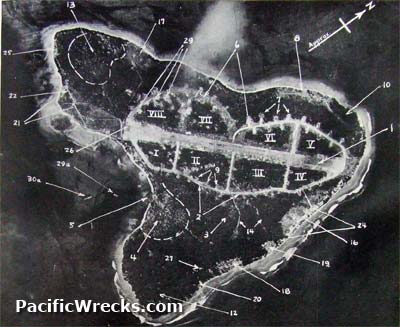 USAAF February 26, 1943 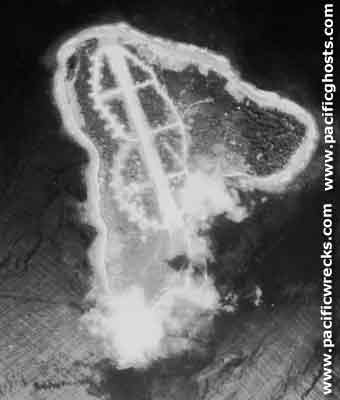 17th PRS February 27, 1943 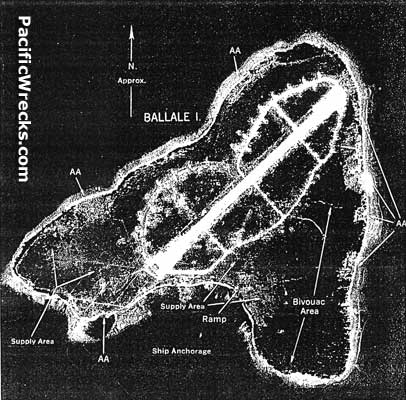 USAAF March 5, 1943 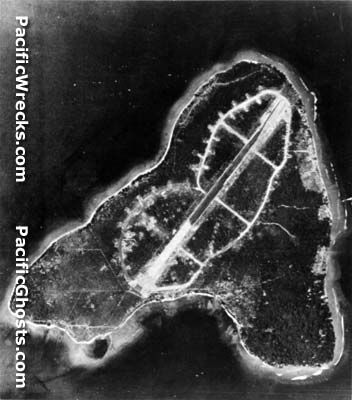 USAAF March 30, 1943 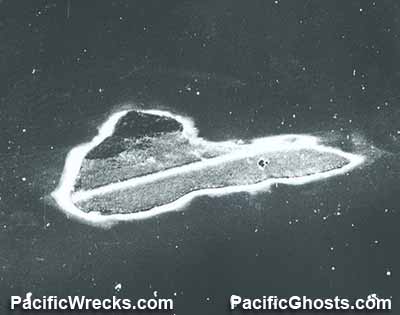 USN October 11, 1943 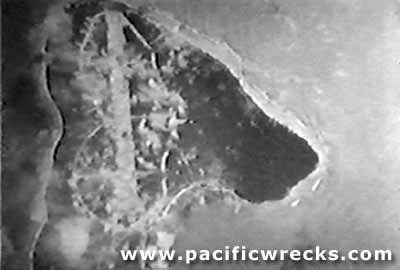 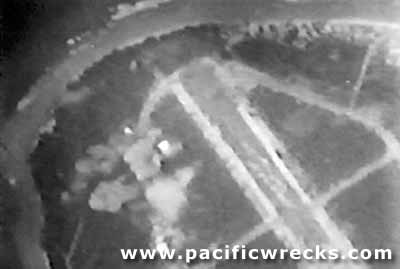 USAAF October 18, 1943 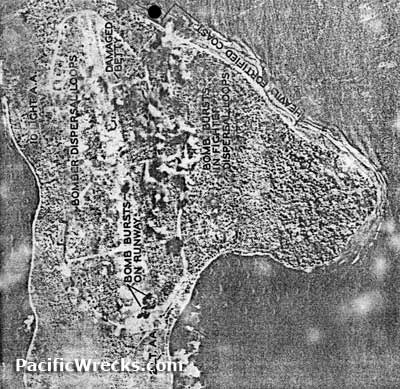 VD-1 December 6, 1943 |
Location Lat 6° 59' 27S Long 155° 53' 12E Ballale Airfield spans the length of Ballale Island. Prewar and during the Pacific War part of the North Solomons in British Solomon Islands Protectorate (BSIP). Today located in Western Province in Solomon Islands. Still in use today, spelled Ballalae Airport. Also spelled "Ballalae" or "Ballalai" (both present day Solomon Islands spelling) or "Ballale" (World War II Allied spelling). Prewar In 1901, Englishman Sam Atkinson purchased the island as free-hold owner. He established a coconut palm plantation harvesting copra that eventually encompassed a total of 307 acres. When Sam Atkinson died in 1931, his wife Edith continued to manage the plantation to was less profitable due to the Great Depression and drop in the price of copra as a commodity. In early 1942, the British Solomon Islands Protectorate (BSIP) government ordered all Europeans evacuated from the Solomons Islands. Edith left the plantation and released the laborers, she hurriedly departed by boat then aboard a ship to Australia. Although she hoped to return quickly, she remained in Australia until the end of World War II. Construction On November 3, 1942 the Imperial Japanese Navy (IJN), 18th Construction Battalion landed on Ballale Island to begin building an airfield with a contingent of 370 personnel later augmented by local people augmented by 517 British Prisoners Of War (British POWs) were transported to Ballale Island as laborers. The Japanese built a single runway that spanned the length of the island oriented roughly northeast to southwest surfaced with crushed coral. Since most of the island was planted with rows of coconut palms, the palm trees were simply cut down at the base and the logs removed. Drainage ditches from the plantation were expanded to remove rain water from rain storms. By January 1943, the runway was completed. Taxiway loops and plus revetments (entaigo) for fighters and bombers were added to each side of the runway. Landing mat were added to taxiways and revetments and to provide extra traction in wet areas. Wartime History The Japanese code named Ballale Island and Ballale Airfield with the three letter signifier "RXZ". On January 9, 1943 the first aircraft to land on the new runway was G3M2 Nell piloted by Iwasaki. During 1943, Ballale Airfield was further developed and used as a forward airfield for Imperial Japanese Navy (IJN) bombers and fighters. Later, Ballale Airfield was also used by Japanese Army Air Force (JAAF) fighters and bombers. Ballale Airfield and the garrison defending Ballale Island were both Imperial Japanese Navy (IJN) and Imperial Japanese Army (IJA) personnel. The construction and anti-aircraft defenses were Navy personnel. Imperial Japanese Navy (IJN) units based at Ballale 2nd Carrier Division (Vice-Admiral Kakuji Kakuda) HQ Rabaul forward base Ballale for missions over Guadalcanal Zuiho Sentouki-tai (18 x A6M Zero detachment) Operation-I arrives April 6, 1943 departs Rabaul Hiyo Sentouki-tai (A6M Zero detachment) Operation-I arrives April 7, 1943 departs Rabaul 204 Kokutai (A6M Zero detachment) 251 Kokutai (J1N1 Irving detachment) June 30, 1943–October 12, 1943 702 Kokutai (G4M1 Betty detachment) middle May 1943 - June 30, 1943 Vunakanau 705 Kokutai (G4M1 Betty detachment) Japanese Army Air Force (JAAF) units based at Ballale 11th Sentai (Ki-43-I Oscar detachment) January 27, 1943 raid to Guadalcanal Japanese base defense units 18th Construction Battalion November 3, 1942–January 1943 6th Kure Chinjufu / 6th Kure Naval Base (3 x Type 89 12cm Naval Guns) Talahashi Group, Kanehara Group 7th Yokosuka Chinjufu Miyake (4 x 7cm Anti-Aircraft guns) 13th Anti-Aircraft Group (Imoo Group) British Prisoner Of War (POWs) A contingent of 517 British Prisoners Of War (British POWs) that surrendered in February 1942 in Singapore detained at Changi POW Camp then shipped to Rabaul were transported to Ballale where they performed manual labor for the Japanese without medicine and were forbidden from digging air raid shelters. Many died from harsh treatment or during Allied bombing raids. The remainder were all killed around March 1943 when the airfield was completed and Japanese feared an Allied landing in the area. In addition, Chinese and Solomon Islander from the surrounding area labored for the Japanese on Ballale. Height of Ballale The height of Ballale Airfield was during the early months of 1943, when it was used for bombers and fighter detachments (Southern Area Fleet Nanha Momen Kantai). On April 6, 1943 Japanese carrier planes begin arriving at Ballale for Operation I-Go and Allied intelligence spots 95 aircraft at Ballale Airfield, likely the highest number of planes on the island. On April 7, 1943 most of these planes took off for X Attack strike against Allied ships in Tulagi Harbor. On May 13, 1943 Allied intelligence spotted 96 fighters and one bomber, another high number of planes on the island. Destination Admiral Yamamoto Never Reached After Operation I-Go, Admiral Yamamoto and his staff planned to inspect forward airfields to boost morale and praise the Army-Navy cooperation. On April 18, 1943 at 6:00am, two bombers: G4M1 Betty 2656 and G4M1 Tail 326 took off from Lakunai Airfield near Rabaul on a flight scheduled to arrive at Ballale Airfield at 8:00am. Instead, both bombers were shot down by P-38 Lightnings. G4M1 Betty 2656 with Admiral Yamamoto aboard was shot down over Bougainville. The other G4M1 Tail 326 with Admiral Ugaki aboard was shot down in the sea off Moila Point on Bougainville. Allied Air Raids During late 1942, American aircraft first detected Ballale Airfield. Starting in January 1943, the island was the target of hundreds of Allied bombing missions, fighter sweeps and strafing runs. The island was also the target of U.S. Naval bombardments by Allied cruisers and destroyers. By the middle of October 1943, Ballale Airfield was neutralized as a forward airfield and the remaining aircraft in flyable condition were withdrawn northward. Although neutralized as an airfield, the island's anti-aircraft guns and defenses remained a threat to aircraft and ships until the end of the Pacific War. American missions against Ballale January 15, 1943–October 19, 1944 Tom Blackburn in VF-17 The Jolly Rogers recalls the accuracy of AA: "Dubbed 'Ballale Postgraduate School for Frustrated Anti-Aircraft gunners'. On the way home from missions we would strafe Ballale. I was never convinced that we did enough damage to warrant the risks, but I am certain our on going efforts inflicted psychological damage. Still I am not sure that it was worth the deaths sustained at the hands of their anti-aircraft gunners." By the middle 1943, the Japanese feared an American invasion of the island, due to increased bombing raids and sea bombardments. Around the middle of 1943, the remaining Solomon Islander laborers were sent away, and the Japanese executed the remaining British POWs. The British bodies were buried in a mass grave, so as not to attract attention from a large fire for cremation that would generate smoke. Later, the garrisons was made to believe or coached to lie that the graves were Japanese personnel killed in air raids. Bypassed After the November 1, 1943 U.S. landing at Torokina the northern Solomon Islands including Ballale was was bypassed and left to "wither on a vine". Cut off from resupply or reinforcement, the remaining garrison began to cultivate crops to sustain themselves. Some Japanese attempted to swim northward to Bougainville using empty fuel drums for flotation. At the end of the Pacific War, the island's garrison was 480 Japanese defenders manning the remaining guns including 321 from the 6th Kure SNLF and 159 from the 7th Yokosuka SNLF. Postwar On November 10, 1945 the first Allied troops to visit the island were elements of the Australian Army 7 Infantry Battalion. The landing party included Lt. General V. A. H. Sturdee (1st Army) and Brigadier A. W. Potts (23 Infantry Brigade). Ashore, the Australians immediately located the bodies of 57 prisoners killed on the island, and buried in shallow trenches. An atrocities commission was carried out on the island, that eventually led to the discovery of a mass grave of 436 bodies were exhumed with artifacts identifying them as British artillerymen, brought to Ballale from Singapore, where they surrendered in February 1942. They were re-interred in individual graves at the Bomama War Cemetery near Port Moresby, PNG. The remainder of the 517 British POWs have never been found. Repair by British Government After the war, the strip was abandoned until 1973 when it was reopened by a grant from the British Colonial government. School children from the nearby Nila Catholic church were used to first clear the runway of bush and move live ordinance. Later, British engineers completed the work, and built a small terminal at the southern end of the strip and dock (now broken) for small boats. Michael Claringbould visited in 1977: "The Japanese workshops still had tools hanging on the walls. Bulldozers, steamrollers, aircraft everywhere, you would not have believed it - frozen in time." Allan Dickes (grandson of Sam Atkinson) recalls: "The most ironic memento of failed imperial ambition was a 'Betty" bomber on whose canopy a ficus had seeded, Its roots had wrapped around the fuselage and now lift the plane skyward once again! Nearby is the up tilted carcass of a 'Zero'. Half the fuselage is buried by soil thrown up by a nearby crater, the 'Rising Sun' emblem, still faintly discernible, is neatly bisected by the soil. The sun had surely set on that one!" Today Ballalae Airport is in limited use today by Solomon Airlines with bi-weekly flights providing air service to the Shortland area. Airport codes: IATA: BAS, ICAO: AGGE. The runway is 5' above sea level. Aside from passengers on the bi-weekly flights, no one lives on Ballale, and the rest of the island has reverted to dense jungle. Full of swamp and dense jungle, Ballale is notorious for scrub typhus, and other varieties of insects, diseases and dangers. Two anthologist that stayed overnight on the island, and died soon afterwards from the tropical aliments. Others report strange rashes, bites and infections from insects of the island. On April 2, 2007, an 8.1 earthquake caused a tsunami tidal wave that impacted many areas of Western Province. Ballale Island's northeastern coast was hit by a tidal wave of undetermined size or strength that knocked over trees. caused flooding and impacted several wrecks in that portion of the island. Mass Grave of British POW & Memorial When Australian forces arrived on the island in November 1945, 436 bodies were exhumed with artifacts that identified them as British artillerymen. They were exhumed and temporarily buried at the nearest Allied War Cemetery at Torokina. Later, they were permanently re-interred at Bomama War Cemetery outside Port Moresby, and are also memorialized at Kranji War Cemetery on the Singapore Memorial. During July 2003, relatives of British POWs visited the island. On July 12, 2003 they dedicated a memorial next to the terminal. List of British Prisoners Killed on Ballale Are you a relative? Contact Us to add name Aircraft Salvaged from Ballale Robert Diemert 1968, Patrick Murphy 1990s, Craig Turner 2005 and Warbird Restoration Pty Ltd 2018 Broken Wings of Ballale - The Tragic Salvage History of the Last Undisturbed World War II Airfield D3A2 Val Manufacture Number 3178 Salvaged by Robert Diemert in 1968, restored to flying condition in storage at Planes of Fame A6M2 Zero Manufacture Number 5356 Tail EII-102 Salvaged by Robert Diemert in 1968 restored to fly with the CAF A6M2 Zero Manufacture Number 5450 Tail EII-140 Salvaged by Robert Diemert in 1968 static restored at NMNA A6M3 Zero Manufacture Number 3471 Salvaged by Robert Diemert in 1968 A6M3 Zero Manufacture Number 3285 Tail 3-174 (?-134) Tail pieces salvaged by Robert Diemert in 1968 A6M3 Model 22 Zero Remained in situ possibly parts salvaged in 1968 rest salvaged by Craig Turner November 6, 2007 References Ballale Naval Engineering Group (1994) by Kotaro Sato COFEPOW - "The Gunners 600" COFEPOW - The Ballale Island Gunners via WayBackMachine January 15, 2017 OneNews "Shortland & Ballalae Aircraft Salvage" November 20, 2007 GJD Services - Solomon's via WaybackMachine February 28, 2008 Contribute
Information Last Updated
|
Map August 4, 1943 Map 1969 Map Fallingrain Map Mapcarta View in Google Earth Memorial Dedication |
| Discussion Forum | Daily Updates | Reviews | Museums | Interviews & Oral Histories |
|